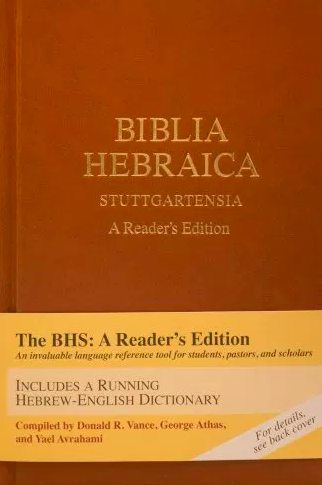You spend time learning massive amounts of paradigms ad nauseum, learned the definitions of words that look the same (at least you did for the quiz), and you’ve even learned some syntax to boot. But now you’ve completed the course, and in order to keep going on, you have to read the thing. Where does one start reading Hebrew?
Some students are motivated enough to pick up their BHS and their lexicon, but not everyone is so motivated. After passing Crucible I and II, you take your summer vacation “break,” but you almost never look back. How do you begin reading Hebrew again? The poetry and the prophets can require hours of searching through a lexicon for the appropriate words for only a mere few verses. I have a good feel for the weak roots because of my professor, Peter Gentry, but hollow roots are still a pain.
The Biblia Hebraica Stuttgartensia: A Reader’s Edition (hereafter, BHSR) was created with the student who has had at least one year of Hebrew in mind. The lexical and grammatical apparatus was put together by Donald Vance, George Athas, and Yael Avrahami. The BHSR gives glosses to works occurring fewer than 70 times. Words occurring 70 or more times are placed in the glossary in the back of the Bible. The glosses are based primarily on the Hebrew and Aramaic Lexicon or the Old Testament (HALOT), along with Brown-Driver-Briggs (BDB), and David Cline’s Dictionary of Classical Hebrew (DCH). The glosses are given according to the context.
Parsing
All words—nouns, verbs, infinitives, participles, adverbs, etc.—occurring fewer than 70 times are parsed, and all verbs with pronominal suffixes are parsed. The most common weak roots are not parsed; however, a list is provided in the introduction.
Before I had this Bible, I had read some complaints about the parsing system, and it is different (unless you are familiar with LaSor’s Handbook of Biblical Hebrew). For example, יְבָרֶכְךָ֖ occurs near the end of Deuteronomy 14.24. It is a Piel Imperfect 3ms with a 2ms suffix. Writing that out for all occurrences fewer than 70 times throughout the entire OT is much too long, even with a very abbreviated form. Instead, in a modification of LaSor’s approach, D20s2 is written.
D = Doubled middle radical (Piel)
20 = Imperfect 3ms
s2 = Pronominal suffix 2ms
It does take some time to get used to, and it requires plenty of flipping back and forth to the introduction, but it really pays off and it keeps and already large Bible from becoming a juggernaut.
The BHSR sections off the lines of poetry extremely well. Unlike narrative portions of Scripture (see the Exodus 19 picture further down the page), the biblical text is spaced out to help you see the poetic meter. Both the poetic and the prophetic portions of the OT don’t follow the Hebrew grammar rules first and second year students usually learn. To represent these texts similarly to the narrative portions would be confusing, as one verse would have multiple subjects, verbs, direct objects, and so on. Representing it as seen below helps one to see the author’s poetic symmetry.
The Spoiled Milk
The introduction explains the parsing system and provides the shorthand meanings (as my example above). However, the full shorthand paradigm is one two separate pages. The headings are on one page with half of the parsings, while the other half is on the next page without the headings. I constantly flip back and forth to see which numbers correspond to their proper headings. You can find the single page parsing system here at William Ross’ website.
The other small downside, which others have noted too, is has to do with the footnotes each uncommon word (<70x) receives. Each verse begins with footnote a, then b, then c, and so on. Often, as I’m reading and I see a word I don’t know, I’ll look down to footnote a only to see that there are 7 other “footnote a’s,” and I don’t know which verse I’m on (there are 16 footnote a‘s in the Exodus 19 picture below). Which footnote a should I be looking at? I have to go back up to find the verse I’m on and then go back down to find the appropriate gloss. It isn’t a big deal, but when I’m quickly looking back and forth between the text and the glosses, it’s easy for me to forget to pay attention to the verse numbers. Rather than having the footnote alphabet refresh with every new verse, instead I think a better system would be to have each footnote alphabet refresh with every new chapter or have a numbering system like the Reader’s Greek NT.
Recommended?
This comes highly recommended. Small annoyances aside, the BHSR meets my needs and helps me grow in my vocabulary and in my ease of reading the Hebrew Bible, which I hope to continue for years to come.
Lagniappe
- Hardcover: 1800 pages
- Publisher: Hendrickson Publishers (January 1, 2015)
Buy it from Amazon
Review Disclosure: I received this book free from Hendrickson Publishers. The opinions I have expressed are my own, and I was not required to write a positive review. I am disclosing this in accordance with the Federal Trade Commission’s 16 CFR, Part 255 http://www.access.gpo.gov/nara/cfr/waisidx_03/16cfr255_03.html.
Amazon Affiliate Disclosure: As an Amazon Associate I earn from qualifying purchases.


Reblogged this on Talmidimblogging.
LikeLike
Reblogged this on Hendrickson Publishers Blog.
LikeLike